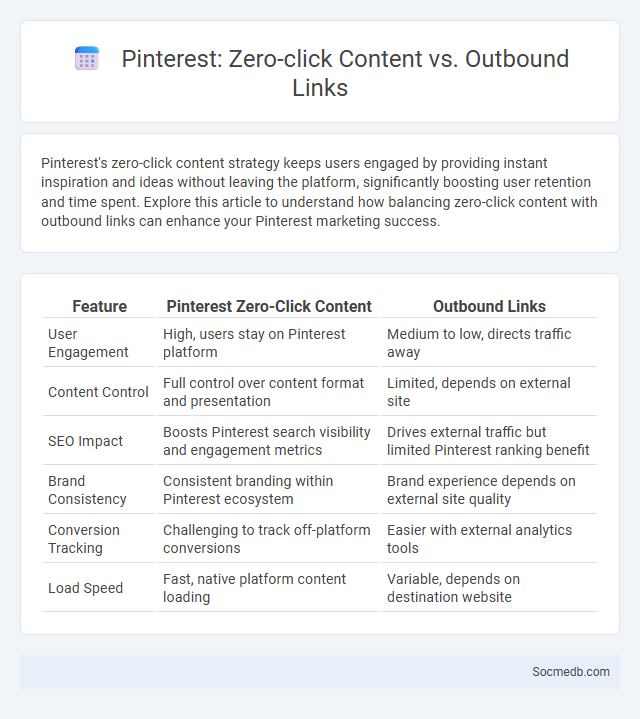
Photo illustration: Pinterest Zero-click content vs Outbound Links
Pinterest's zero-click content strategy keeps users engaged by providing instant inspiration and ideas without leaving the platform, significantly boosting user retention and time spent. Explore this article to understand how balancing zero-click content with outbound links can enhance your Pinterest marketing success.
Table of Comparison
| Feature | Pinterest Zero-Click Content | Outbound Links |
|---|---|---|
| User Engagement | High, users stay on Pinterest platform | Medium to low, directs traffic away |
| Content Control | Full control over content format and presentation | Limited, depends on external site |
| SEO Impact | Boosts Pinterest search visibility and engagement metrics | Drives external traffic but limited Pinterest ranking benefit |
| Brand Consistency | Consistent branding within Pinterest ecosystem | Brand experience depends on external site quality |
| Conversion Tracking | Challenging to track off-platform conversions | Easier with external analytics tools |
| Load Speed | Fast, native platform content loading | Variable, depends on destination website |
Understanding Pinterest Zero-Click Content
Pinterest zero-click content refers to pins that provide complete information directly on the platform, eliminating the need for users to click through to external websites. This format enhances user experience by delivering instant value, increasing engagement, and encouraging longer time spent browsing. Optimizing your Pinterest content for zero-click interactions can significantly boost visibility and drive better organic reach within the platform.
Defining Outbound Links on Pinterest
Outbound links on Pinterest direct users from your pins to external websites, enhancing traffic and boosting SEO for your content. By strategically placing relevant outbound links, you can increase engagement and drive potential customers to your online store or blog. Ensure your outbound links are accurate and lead to valuable resources, optimizing your Pinterest presence for better visibility and user experience.
What is Zero-Click Content?
Zero-click content refers to information designed to provide immediate answers within search engine results or social media feeds, eliminating the need for users to click through to external websites. It leverages rich snippets, featured snippets, and knowledge panels to deliver concise, easily digestible information directly on the platform. This strategy enhances user experience by reducing search friction and increasing content visibility on platforms like Google, Twitter, and Facebook.
Core Differences Between Zero-Click Content and Outbound Links
Zero-click content delivers information directly on the social media platform, enhancing user engagement by eliminating the need to leave the site, which increases session duration and reduces bounce rates. Outbound links redirect users to external websites, driving traffic away from the platform but are essential for SEO strategies and lead generation. The core difference lies in user interaction: zero-click content prioritizes instant information access, while outbound links focus on expanding audience reach and fostering deeper engagement outside social media.
User Engagement: Zero-Click vs Outbound Strategies
Maximizing user engagement on social media relies on balancing zero-click and outbound strategies to meet your audience's preferences. Zero-click strategies emphasize in-platform interactions like likes, comments, and shares, keeping users engaged without leaving the site. Outbound strategies drive traffic to external content, enhancing brand visibility and conversion opportunities beyond social media channels.
SEO Implications for Pinterest Zero-Click Content
Pinterest's zero-click content enhances SEO by keeping users engaged on the platform, increasing dwell time which signals content relevance to search engines. Your content optimized for Pinterest's visual search and keyword-driven pins boosts visibility without requiring external clicks. Emphasizing rich, keyword-focused descriptions and high-quality images leverages Pinterest's algorithm, driving organic traffic and improving brand discoverability.
Content Reach and Virality: Which Approach Wins?
Content reach on social media depends heavily on targeted audience engagement and algorithmic favorability, maximizing visibility through strategic timing and relevant hashtags. Virality thrives on emotional resonance, shareability, and unique, trending formats that compel widespread sharing and interaction. Balancing both strategies by crafting relatable yet broadly appealing content often yields the most effective results in growing influence and online presence.
Conversion Rate Analysis: Outbound Links vs Zero-Click
Conversion rate analysis in social media reveals significant differences between outbound links and zero-click engagements. Outbound links typically drive higher conversion rates by directing users to targeted landing pages, enhancing measurable actions like purchases or sign-ups. Zero-click interactions, including likes, comments, and shares, boost brand awareness and engagement but present challenges in direct conversion tracking.
Best Practices for Pinterest Content Optimization
Optimizing Pinterest content requires using high-quality, vertical images with a 2:3 aspect ratio to maximize visibility and engagement. Incorporate relevant keywords naturally in pin titles, descriptions, and board names to improve searchability and attract targeted audiences. Consistently pinning during peak times and engaging with followers through comments and collaborations enhances algorithm favorability and boosts organic reach.
Choosing the Right Pinterest Content Strategy
Selecting the right Pinterest content strategy involves understanding your target audience's interests and behaviors to create visually appealing pins that drive engagement. Leveraging keyword-rich descriptions and optimizing pin designs for mobile browsing enhances discoverability and click-through rates. Regularly analyzing Pinterest analytics helps refine content focus, ensuring alignment with trending topics and seasonal demands to maximize reach and conversions.
 socmedb.com
socmedb.com